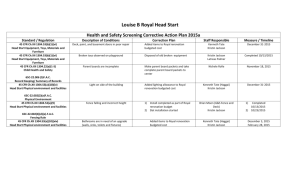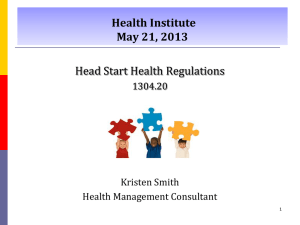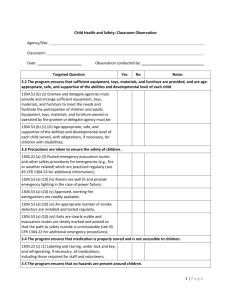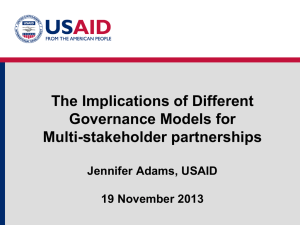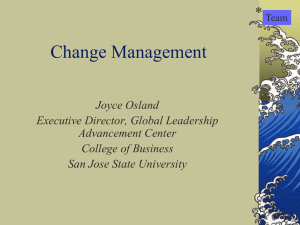Governance Powerpoint January 2011
advertisement
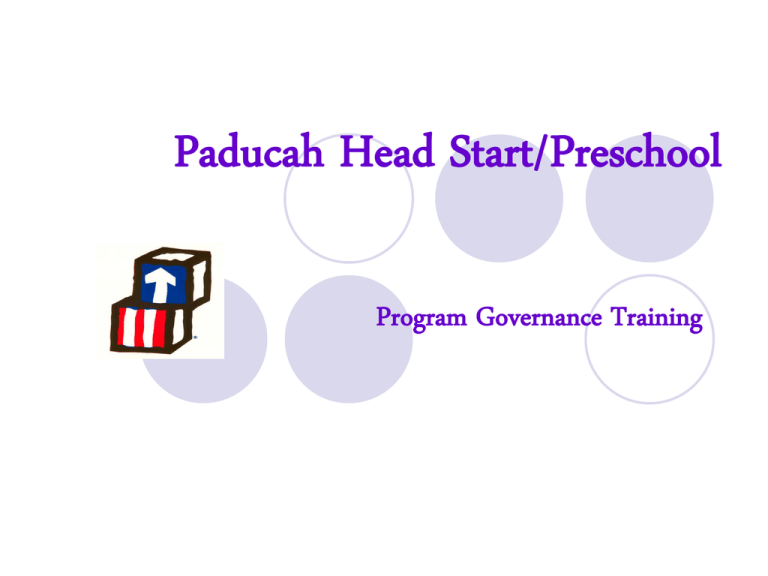
Paducah Head Start/Preschool Program Governance Training “Stitching the Services Together” Head Start Program Overview Federal Program that began in 1965 Program for low-Income preschool children and their families Head Start promotes the school readiness of low-income children by enhancing their cognitive, social and emotional development Comprehensive child development program designed to include the following service areas Early Childhood Development & Health Services Family & Community Partnerships Program Design and Management What makes a Head Start Program different from other early childhood programs? Parents are empowered to actively participate in the shared decision-making process about all aspects of their child’s program through a formal structure of shared governance. What is Program Governance? Program governance is the formal structure that provides parents and other community representatives with the authority and opportunity to participate in shared decision-making concerning program design and implementation. Policy Council Members are: Parents of children currently enrolled Community Representatives Key Individuals & Groups Responsible for Head Start Decision Making Governing Body – Paducah Public School Board Agency Director – Superintendent Dr. Randy Greene Program Director – Head Start Director Frances Smith Policy Council – Membership must be at least 51% of parents of children currently enrolled in the program Policy Council Responsibilities Under the new Head Start Law, the Policy Council must approve and submit to the Board, decisions about each of the following activities: Activities to support the active involvement of parents in supporting program operations, including policies to ensure that the Head Start agency is responsible to community and parent needs. Policy Council Responsibilities Program recruitment, selection and enrollment priorities. Applications for Head Start funding and amendments to such applications, prior to submission of applications. Budget planning for program expenditures, including policies for reimbursement and participation in Policy Council activities. Policy Council Responsibilities Bylaws for operation of the Policy Council. Program personnel policies and decisions regarding the employment of program staff consistent with the Board’s responsibilities in this area, including standards of conduct for program staff, contractors and volunteers and criteria for the employment and dismissal of program staff. Developing procedures for how members of the Policy Council will be elected. Roles & Responsibilities Program Design and Operation Strategic Planning (Needs Assessment and SelfAssessment) Approve and submit program oriented policies to the Board. Long and short-term planning goals and objectives Head Start Act Governing Body Responsibilities Assure active, independent, informed governance; select independent auditors Fully participate in development, planning and evaluation of EHS/HS program Legal & fiscal responsibility Board Responsibilities Must assure compliance with Federal, state and local laws and regulations; And much more . . . . . . . Review and approve all major policies; Information Sharing Information Sharing must include: Grantees must ensure sharing of accurate and regular information for Board and Policy Council re: planning, policies and Head Start operations. Monthly Financial Statements Monthly Program Information Summaries Program enrollment reports Financial Audits Annual Self-Assessment Community wide strategic planning and needs assessment Communication fro the HHS Secretary Program Information Reports Head Start Performance Standards The Head Start Performance Standards are designed to ensure that the Head Start goals and objectives are implemented successfully, that the Head Start philosophy continues to thrive, and that all grantee and delegate agencies maintain the highest possible quality in the provision of Head Start services. Head Start Performance Standards Mandatory regulations Must implement in order to operate a Head Start program. Define objectives and features of a quality Head Start program Performance Standards 1304.20 1304.21 1304.22 1304.23 1304.24 1304.40 1304.41 1304.51 1304.52 1305 1310 Child Health and Development Services Education and Early Childhood Development Child Health and Safety Child Nutrition Child Mental Health Family Partnerships Community Partnerships Management Systems and Procedures Human Resources Management ERSEA Transportation Paducah Head Start/Preschool Mission Statement Paducah Head Start/Preschool provides an exceptional child development program by building compassionate partnerships with families and positively influencing the future of our society Summary The overall effect of the changes should be better informed Boards and Policy Council and therefore, an even stronger program serving our children and families. The Ten Commitments of Leadership Challenging the Process 1. Search out challenging opportunities to change, grow, innovate, and improve. 2. Experiment, take risks, and learn from the accompanying mistakes. Inspiring a Shared Vision 3. Envision an uplifting and ennobling future. 4. Enlist others in a common vision by appealing to their values, interests, hopes, and dreams. Enabling Others to Act 5. Foster collaboration by promoting cooperative goals and building trust. 6. Strengthen people by giving power away, providing choice, developing competence, assigning critical tasks, and offering visible support. Modeling the Way 7. Set the example by behaving in ways that are consistent with shared values. 8. Achieve small wins that promote consistent progress and build commitment. Encouraging the Heart 9. Recognize individual contributions to the success of every project. Leadership Challenge 10. Celebrate accomplishments regularly. M-O-V-E-R Qualities What are the qualities of effective leaders? One outstanding quality of leadership is their dedication to learning. Effective leaders ask more questions than they answer and use this technique to instruct others. Rather than showing a person how to do something, they ask the questions that lead the person to discover the solution. Leader act as Mentors by guiding, coaching, supporting, and providing a safe environment in which others may grow. Effective leaders engage in Outreach beyond the confines of the organization building partnerships throughout the community. They have a clear idea of what is important, how to achieve it, and how to communicate enthusiasm to everyone about their vision. Visionary leaders recognize the importance of inspiring others to be proactive. They want to teach others to anticipate future opportunities and the challenges of change. Strong leaders Empower others to believe in the vision and play vital roles in making it happen. They provide the tools and support for others to make decisions and succeed. Finally, great leaders lead by example. They are Role Models, teaching others who look to them for guidance. LEADERSHIP MYTHS Myth 1: Leadership is a rare skill. Everyone has leadership potential. Great leaders simply develop their potential. You can be a leader in one area of your life while have a different role in another part of your life. Myth 2: Leaders are born, not made. Many leaders had very humble beginnings. They attained leadership positions through hard work and experience. Becoming a leader may not be easy and there is no simple do-it-yourself guide to leadership. However, if you prepare yourself and are willing to put forth the effort, leadership can be learned. Myth 3: Leaders must be charismatic. Leaders come in all shapes, sizes, colors, and cultural backgrounds. There are no requirements for any certain type of physical appearance, health, personality, or style. Myth 4: Leadership exists only at the top of an organization. Have you noticed that the most successful organizations have many people who are willing and able to assume leadership positions—not just the top management person? Strong leadership breeds leaders. All programs and organizations have plenty of room for leaders. Myth 5: Leaders control, prod, and manipulate. Leadership should not be seen as an exercise of power, but rather as the empowerment of others. Good leaders do not need to control and manipulate others. People should accept leadership, not be coerced into following it. Good leaders lead by: •Pulling, not pushing •Inspiring, not ordering •Enabling people to use their own initiative, not control •Setting attainable goals, not unreasonable expectations •Rewarding progress, not by ignoring achievement.

